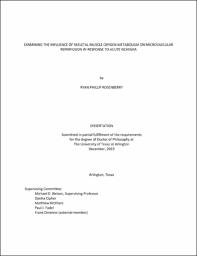
ATTENTION: The works hosted here are being migrated to a new repository that will consolidate resources, improve discoverability, and better show UTA's research impact on the global community. We will update authors as the migration progresses. Please see MavMatrix for more information.
Show simple item record
| dc.contributor.advisor | Nelson, Michael D | |
| dc.creator | Rosenberry, Ryan Phillip | |
| dc.date.accessioned | 2020-01-10T22:24:16Z | |
| dc.date.available | 2020-01-10T22:24:16Z | |
| dc.date.created | 2019-12 | |
| dc.date.issued | 2019-12-03 | |
| dc.date.submitted | December 2019 | |
| dc.identifier.uri | http://hdl.handle.net/10106/28864 | |
| dc.description.abstract | Cardiovascular disease (CVD) is the single leading cause of morbidity and mortality in the United States (and the world), with a death rate greater than cancer and chronic lower respiratory disease (emphysema, bronchitis, asthma) combined. Therefore, it is critically important to continue developing techniques for assessing cardiovascular disease. Reactive hyperemia (RH), the magnitude of tissue reperfusion following a period of transient ischemia, is a common technique that is conventionally interpreted as an index of microvascular function and has been shown to be a sensitive and powerful predictor of cardiovascular risk factors and future cardiac events. In Chapter 2, we provide historical and clinical context for the measurement of reactive hyperemia, discuss the tools that have been used measure this phenomenon, summarize the mechanisms purportedly driving this response, and discuss emerging analytical approaches. In Chapter 3 we used near-infrared spectroscopy to evaluate the effect of age on reactive hyperemia. In Chapter 4 we further pursued this line of inquiry and incorporated Doppler ultrasound to evaluate the relationship brachial artery reactive hyperemia. In these studies we found that tissue ischemia is an important determinant of the hyperemic response. In Chapter 5 and Appendix A, we manipulated the balance between the ischemic stimulus and microvascular reactivity. In Appendix A, we attempted to acutely impair microvascular by exposing healthy young participants to an ischemia-reperfusion model, but failed to induce any impairment in reactive hyperemia. In Chapter 5 we employed limb immobilization to induce reductions in skeletal muscle mitochondrial, but again were unable to induce shifts in either mitochondrial function or reactive hyperemia. Overall, these investigations have provided novel insight into the complex, and previously overlooked, relationship between skeletal muscle metabolic rate and reactive hyperemia. However, more work is needed to further explore this complex interrelationship and how it is affected by aging and disease. | |
| dc.format.mimetype | application/pdf | |
| dc.language.iso | en_US | |
| dc.subject | Microvascular | |
| dc.subject | Reactive hyperemia | |
| dc.subject | Near-infrared spectroscopy | |
| dc.subject | Ischemia | |
| dc.title | EXAMINING THE INFLUENCE OF SKELETAL MUSCLE OXYGEN METABOLISM ON MICROVASCULAR REPERFUSION IN RESPONSE TO ACUTE ISCHEMIA | |
| dc.type | Thesis | |
| dc.degree.department | Kinesiology | |
| dc.degree.name | Doctor of Philosophy in Kinesiology | |
| dc.date.updated | 2020-01-10T22:26:26Z | |
| thesis.degree.department | Kinesiology | |
| thesis.degree.grantor | The University of Texas at Arlington | |
| thesis.degree.level | Doctoral | |
| thesis.degree.name | Doctor of Philosophy in Kinesiology | |
| dc.type.material | text | |
Files in this item
- Name:
- ROSENBERRY-DISSERTATION-2019.pdf
- Size:
- 4.826Mb
- Format:
- PDF
This item appears in the following Collection(s)
Show simple item record


